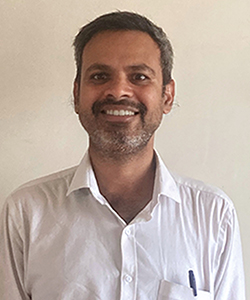
Planting Trees to Foster the Future and Improve Lives
I work with the Agra Metro Project. Although I am from an engineering background, as I read about the Sustainable Development Goals, I fell in love with the idea of contributing to their accomplishment. I love plants and I own a farm in Nagaur District in the state of Rajasthan. But I wasn’t sure initially how I could contribute to the SDGs through my farm. I thought and studied hard on the matter. I came across the shared thoughts of SGI President Daisaku Ikeda and the Nobel Laureate Wangari Maathai: “Planting a tree is planting life; it is fostering the future, fostering peace.”
I realized that it is my duty to contribute to my community through my work; to set a live example to the farmers of my district to move towards agroforestry – bring more agricultural land under tree plantation – increase rain – and improve groundwater table – and ultimately – improve the economic condition of people living in the area.
The primary challenge that the farmers face in Rajasthan is the scarcity of water. Since the traditional way of farming is restricted to monsoons only, therefore, the farmlands are not utilized for 75% of the year. The reason is decreasing rainfall and exploitation of groundwater. There is a direct relation between groundwater and the economic condition of people. The better the availability of water, the better the economic condition. To increase the availability of water, the only option was to receive more rain during monsoons.
Once, when I was on my way to my farm, I noticed that the government had planted Babul trees alongside the roads. The density of tree cover is such that even sunlight does not fall on the ground. The effect is that this area receives more rain than the neighboring areas. As a result of this, the farmers there were engaged in agriculture round the year. And the average income was at least double than the farmers of my village.
To replicate the benefits in my area, I started planning to increase the tree cover. To do so, I visited neighboring districts to study the agroforestry projects. My interaction with the farmers revealed that they were not interested in growing babul trees due to the long gestation period and low returns. I soon encountered an expert who advised me to grow Santalum Album – Sandalwood, along with Malabar Neem trees as hosts.
I started preparing my farm for plantation in the month of May 2021. Boundary wall was erected to protect plants from stray animals. A 25-lakh liter capacity water pond was excavated at the lowest catchment area of the farm. The pond was covered by a 500-micron HDPE sheet to avoid percolation of water. The pond received 20 lakh liters of rainwater in 2021. An additional boundary was erected to avoid animals falling in the deep-water pond. A good quality drip irrigation system was installed to save the precious water accumulated from rain. Due to this system each drop of water gets supplied to the roots of plants efficiently.
By 10th August 2021, more than 2200 saplings were planted. Some local farmers, who had initially doubted the growth of this plant, (as these plants are naturally grown in south Indian forests only), have now got convinced about the prospects of growing the plant in this area as well.
While we faced many challenges, like extreme weather conditions – the winter of 2021 broke the record of the last 20 years as temperature dropped to around 0 degrees Celsius; heat waves started early in March 2022. As a result of this, the baby plant sapling got damaged due to freezing temperatures in winter and hot winds in summer. But we are continuing to work closely with the plants and nurturing them. Many of the saplings are now reviving because of the proper care they are receiving.
I am determined to translate my love for plants to build my community, create livelihood for many farmers, and create peace and happiness for all around me, thereby achieving the SDGs by 2030.



